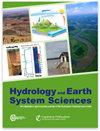Spatio-temporal information propagation using sparse observations in hyper-resolution ensemble-based snow data assimilation
IF 5.8
1区 地球科学
Q1 GEOSCIENCES, MULTIDISCIPLINARY
引用次数: 0
Abstract
Abstract. Data assimilation techniques that integrate available observations with snow models have been proposed as a viable option to simultaneously help constrain model uncertainty and add value to observations by improving estimates of the snowpack state. However, the propagation of information from spatially sparse observations in high-resolution simulations remains an under-explored topic. To remedy this, the development of data assimilation techniques that can spread information in space is a crucial step. Herein, we examine the potential of spatio-temporal data assimilation for integrating sparse snow depth observations with hyper-resolution (5 m) snow simulations in the Izas central Pyrenean experimental catchment (Spain). Our experiments were developed using the Multiple Snow Data Assimilation System (MuSA) with new improvements to tackle the spatio-temporal data assimilation. Therein, we used a deterministic ensemble smoother with multiple data assimilation (DES-MDA) with domain localization. Three different experiments were performed to showcase the capabilities of spatio-temporal information transfer in hyper-resolution snow simulations. Experiment I employed the conventional geographical Euclidean distance to map the similarity between cells. Experiment II utilized the Mahalanobis distance in a multi-dimensional topographic space using terrain parameters extracted from a digital elevation model. Experiment III utilized a more direct mapping of snowpack similarity from a single complete snow depth map together with the easting and northing coordinates. Although all experiments showed a noticeable improvement in the snow patterns in the catchment compared with the deterministic open loop in terms of correlation (r=0.13) and root mean square error (RMSE = 1.11 m), the use of topographical dimensions (Experiment II, r=0.63 and RMSE = 0.89 m) and observations (Experiments III, r=0.92 and RMSE = 0.44 m) largely outperform the simulated patterns in Experiment I (r=0.38 and RMSE = 1.16 m). At the same time, Experiments II and III are considerably more challenging to set up. The results of these experiments can help pave the way for the creation of snow reanalysis and forecasting tools that can seamlessly integrate sparse information from national monitoring networks and high-resolution satellite information.在基于超分辨率集合的雪数据同化中利用稀疏观测数据进行时空信息传播
摘要。将现有观测数据与雪模型相结合的数据同化技术被认为是一种可行的选择,既有助于限制模型的不确定性,又能通过改进对积雪状态的估计来增加观测数据的价值。然而,在高分辨率模拟中如何传播来自空间稀疏观测数据的信息,仍然是一个探索不足的课题。为了解决这一问题,开发能够在空间传播信息的数据同化技术是至关重要的一步。在此,我们研究了时空数据同化技术在整合伊萨斯比利牛斯山脉中部实验集水区(西班牙)稀疏雪深观测数据与超分辨率(5 米)积雪模拟数据方面的潜力。我们的实验是利用多重雪数据同化系统(MuSA)开发的,该系统在时空数据同化方面做了新的改进。在此过程中,我们使用了具有域定位功能的多数据同化确定性集合平滑器(DES-MDA)。为了展示超分辨率雪地模拟中时空信息传递的能力,我们进行了三个不同的实验。实验 I 采用传统的地理欧氏距离来映射单元之间的相似性。实验 II 利用从数字高程模型中提取的地形参数,在多维地形空间中使用马哈拉诺比斯距离。实验三则利用一张完整的雪深图和经纬度坐标,更直接地绘制出雪堆相似度地图。虽然所有实验都显示,与确定性开环相比,集水区的积雪模式在相关性(r=0.13)和均方根误差(RMSE = 1.11 米)方面都有明显改善,但使用地形维度(实验二,r=0.63,RMSE = 0.89 米)和观测数据(实验三,r=0.92,RMSE = 0.44 米)在很大程度上优于实验一的模拟模式(r=0.38,RMSE = 1.16 米)。同时,实验二和实验三的设置难度要大得多。这些实验的结果有助于为创建能够无缝整合来自国家监测网络的稀疏信息和高分辨率卫星信息的积雪再分析和预报工具铺平道路。
本文章由计算机程序翻译,如有差异,请以英文原文为准。
求助全文
约1分钟内获得全文
求助全文
来源期刊

Hydrology and Earth System Sciences
地学-地球科学综合
CiteScore
10.10
自引率
7.90%
发文量
273
审稿时长
15 months
期刊介绍:
Hydrology and Earth System Sciences (HESS) is a not-for-profit international two-stage open-access journal for the publication of original research in hydrology. HESS encourages and supports fundamental and applied research that advances the understanding of hydrological systems, their role in providing water for ecosystems and society, and the role of the water cycle in the functioning of the Earth system. A multi-disciplinary approach is encouraged that broadens the hydrological perspective and the advancement of hydrological science through integration with other cognate sciences and cross-fertilization across disciplinary boundaries.
 求助内容:
求助内容: 应助结果提醒方式:
应助结果提醒方式:


